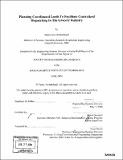| dc.contributor.advisor | Jarrod Goentzel. | en_US |
| dc.contributor.author | Archambault, Nancy June, 1980- | en_US |
| dc.contributor.other | Massachusetts Institute of Technology. Engineering Systems Division. | en_US |
| dc.date.accessioned | 2005-11-03T16:49:27Z | |
| dc.date.available | 2005-11-03T16:49:27Z | |
| dc.date.issued | 2004 | en_US |
| dc.identifier.uri | http://hdl.handle.net/1721.1/29523 | |
| dc.description | Thesis (M. Eng. in Logistics)--Massachusetts Institute of Technology, Engineering Systems Division, 2004. | en_US |
| dc.description | "June 2004." | en_US |
| dc.description | Includes bibliographical references. | en_US |
| dc.description.abstract | As economies grow and companies seek increasing market shares, they must also build the infrastructure within their organization to support that growth. In the grocery business in particular, there are many challenges associated with fleet management and the opportunity to centrally manage the entire fleet is viewed as a cost and time-savings opportunity. This project was conducted in partnership with a grocery retailer with the goal of examining several elements of the companies transportation system and processes with two goals in mind. The first goal was to look for opportunities to reduce cost, total miles traveled, and total empty miles traveled by the fleet. The second goal was to examine current processes and start to determine what changes or approaches should be recommended in pursuit of a central dispatching function to coordinate all movements within the transportation network. For this particular retailer, several areas were identified as potential stepping stones in its plan to begin a central dispatching operation. These areas of opportunity include using third party carriers for store deliveries, planning routes to increase the level of coordination between inbound and outbound transportation, and using the retailer's private fleet to provide carrier service for other shippers. Analysis projected that using third party carriers for outbound store deliveries could save the organization a significant sum of money, more than 1% of annual freight costs. Overall, there are many opportunities to take advantage of network characteristics to improve overall efficiency, reducing total cost and total empty miles traveled; they are discussed in detail. | en_US |
| dc.description.statementofresponsibility | by Nancy June Archambault. | en_US |
| dc.format.extent | 79 p. | en_US |
| dc.format.extent | 4417602 bytes | |
| dc.format.extent | 4426021 bytes | |
| dc.format.mimetype | application/pdf | |
| dc.format.mimetype | application/pdf | |
| dc.language.iso | eng | en_US |
| dc.publisher | Massachusetts Institute of Technology | en_US |
| dc.rights | M.I.T. theses are protected by copyright. They may be viewed from this source for any purpose, but reproduction or distribution in any format is prohibited without written permission. See provided URL for inquiries about permission. | en_US |
| dc.rights.uri | http://dspace.mit.edu/handle/1721.1/7582 | |
| dc.subject | Engineering Systems Division. | en_US |
| dc.title | Planning coordinated loads to facilitate centralized dispatching in the grocery industry | en_US |
| dc.type | Thesis | en_US |
| dc.description.degree | M.Eng.in Logistics | en_US |
| dc.contributor.department | Massachusetts Institute of Technology. Engineering Systems Division | |
| dc.identifier.oclc | 57317140 | en_US |
